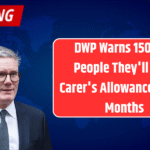As inflation continues to squeeze household budgets across the UK, the government is rolling out one of its most impactful support measures yet. The Department for Work and Pensions (DWP) will distribute Cost of Living Payments throughout 2025, offering up to £500 per eligible household. These payments are a lifeline for millions facing mounting costs on essentials like food, fuel, and housing.
2025 Cost of Living Payments: What’s Coming and When?
The payments aren’t one-time — they’re strategically scheduled to help families when financial pressure is typically highest. Here’s how the support breaks down:
| Phase | Date | Amount | Purpose |
|---|---|---|---|
| Phase 1 | March–May 2025 | £301 | Relief from winter energy bills |
| Phase 2 | July–August 2025 | Up to £200 | Covering rising summer costs like food and utilities |
| Phase 3 | October–December 2025 | Balance up to £500 | Support before the holidays and cold months ahead |
💡 Combined, these phased payments aim to act like a financial cushion during the UK’s most expensive seasons.
Also Read – DWP Warns 150,000 People They’ll Lose Carer’s Allowance In July Months
Who’s Eligible?
You don’t need to fill out any applications — the system is automatic. If you receive one of the following benefits during the official assessment periods, you’re likely on the list:
-
Universal Credit
-
Pension Credit
-
Income Support
-
Income-based Jobseeker’s Allowance (JSA)
-
Income-related Employment and Support Allowance (ESA)
-
Working or Child Tax Credits
-
Housing Benefit
Tip: Keep an eye on your benefit award letters or DWP notices — they’ll confirm if you fall within the assessment window.
Extra Help for Those Who Need It Most
The DWP recognises that some individuals face more intense financial pressure. That’s why vulnerable groups may see additional forms of support, such as:
-
People with disabilities receiving PIP, DLA, or Attendance Allowance
-
Unpaid carers looking after loved ones full-time
-
Households using medical devices that drive up electricity use
In some cases, top-up payments or priority access to emergency support funds may be offered.
How You’ll Get Paid
Forget paperwork and long waits — payments are made directly into the bank accounts used for your benefits. But it’s vital to keep your contact details and banking information updated with the DWP. A small error could mean a big delay.
🚨 If you switch banks, notify the DWP immediately to avoid missed payments
Also Read – DWP Cuts Could Strip Some PIP Claimants of £900 Monthly Support
Why It Matters
In 2024, official statistics revealed that 1 in 4 UK households struggled to afford everyday essentials. The 2025 Cost of Living Payments aim to relieve that burden — especially during seasons when heating bills surge or food prices spike.
Whether it’s keeping your home warm, your fridge stocked, or your care needs covered, this targeted assistance could make a real difference in the months ahead.
What Else Is Available in 2025?
Don’t stop at the Cost of Living Payments — other support programs can add to your household income:
| Program | What It Covers | Typical Value |
|---|---|---|
| Warm Home Discount | Discount on winter electricity | £150 |
| Cold Weather Payment | Extra help during freezing weeks | £25/week |
| Household Support Fund | Grants for food, heating & emergencies | Varies by council |
| Council Tax Reduction | Reduces council tax bills | Varies |
📌 These programs can be combined with the Cost of Living Payments — giving you more financial breathing room.
Final Tips: Be Prepared and Proactive
✅ Check your benefit eligibility regularly
✅ Ensure DWP has your latest bank and contact information
✅ Mark payment windows in your calendar
✅ Reach out to the DWP helpline if anything goes missing
Bottom Line: With food prices still volatile and energy costs high, every pound counts. The DWP’s 2025 Cost of Living Payments offer vital support—but knowing how to make the most of them can stretch that support even further.
Ready to start the year strong? Keep your documents in order, check for local aid, and take full advantage of what’s available. The right knowledge could put hundreds of pounds back in your pocket.



